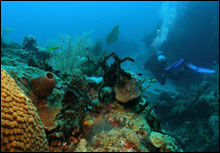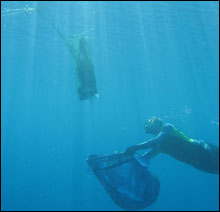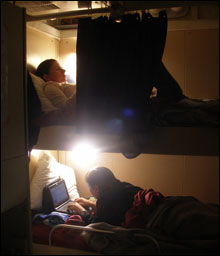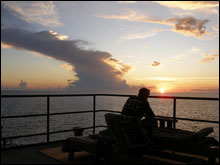Error processing SSI file
|
Mission Blog: Sept. 27, 2009
Chelsea Lowes, Onboard Cruise Log Coordinator
Knauss Sea Grant Fellow, NOAA Ecosystem Research Program
 |
| A diver collects data along the base of the reef. (Photo: NOAA CCFHR) |
We have really been lucking out with the weather on this trip. The ocean was almost smooth today as we started dives. Everyone came back impressed with how beautiful the sites had been and how high the biodiversity in the area is. Fish and coral and sponges and seagrass, oh my!
This morning we went to check on the larval fish traps set out a few days ago to see if there were any larval fish hanging out. To check the traps a snorkeler dives below the traps with a large mesh bag, and then comes up slowly and encloses the traps in the bag.
 |
| Snorkeler approaches larval trap. (Photo: NOAA CCFHR) |
The snorkeler then unhooks the trap and brings it over to the small boat to take a look at the catch. The haul today was not that impressive - only a few larval fish. In order to increase the sample size, we hung the traps back up and will check again in a few days.
 |
| Home away from home.(Photo: NOAA CCFHR) |
Everyone has been adjusting to life on the ship very well. It is quite different from going to work in the morning and then going home in the evening. On the ship, the scientists spend most of their time in the wet and dry labs. The wet lab is where the cameras for diving are set up and tested. This is also where minor equipment repairs take place and where the scientists set up in the evening to run the drop camera operations. The dry lab serves as the office - every spare piece of countertop is packed with laptops, reef fish reference books, dive logs, and coffee mugs.
Staterooms on the ship range from single occupancy for the Commanding Officer and some of the other officers and crew, to quadruple occupancy for the scientists. Everyone gets their own locker for storage and each stateroom has a sink. Since schedules can vary considerably, each bunk has a privacy curtain to block out the room light. We are also careful to keep voices down and avoid slamming doors since there is always at least one person sleeping on the ship at any given time.
 |
| Sunset viewed from steel beach.(Photo: NOAA CCFHR) |
In the evenings, you can find scientists unwinding by watching movies in the lounge, playing board games in the mess hall, or reading in their bunks. "Steel beach" is located behind the bridge (where navigation and control of the Nancy Foster takes place) and is basically an open space with some seating Scientists and crew enjoy reading there after dinner and waiting for the sun to go down. It is an ideal place for star watching.
|



